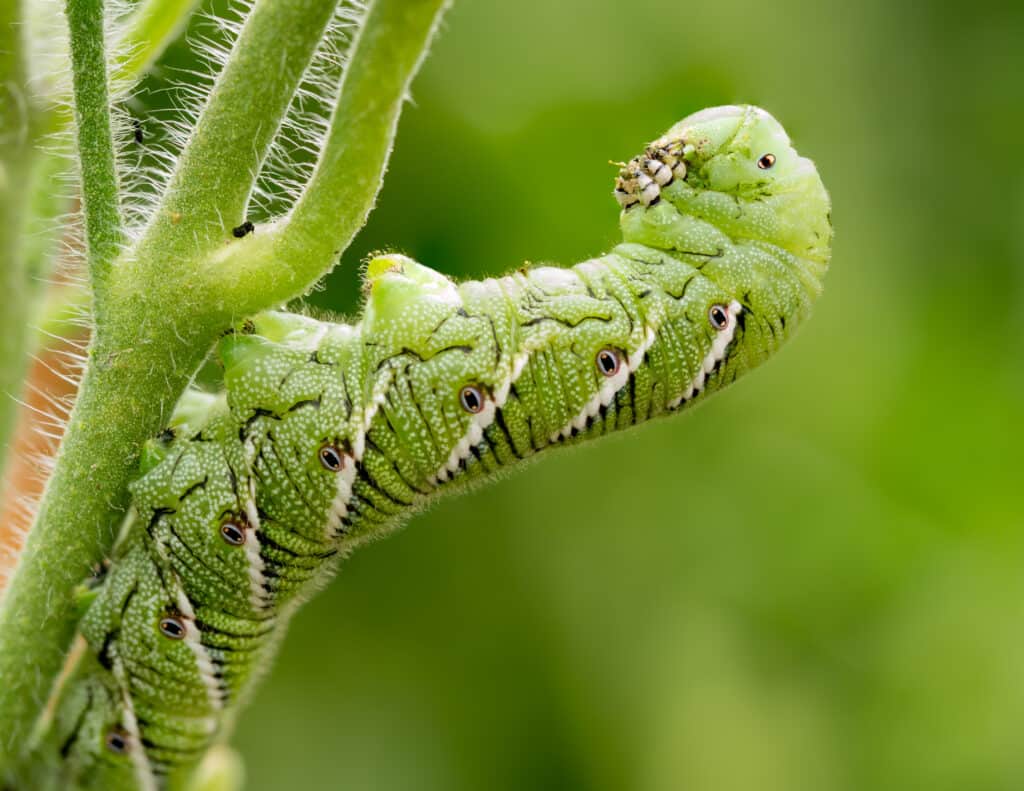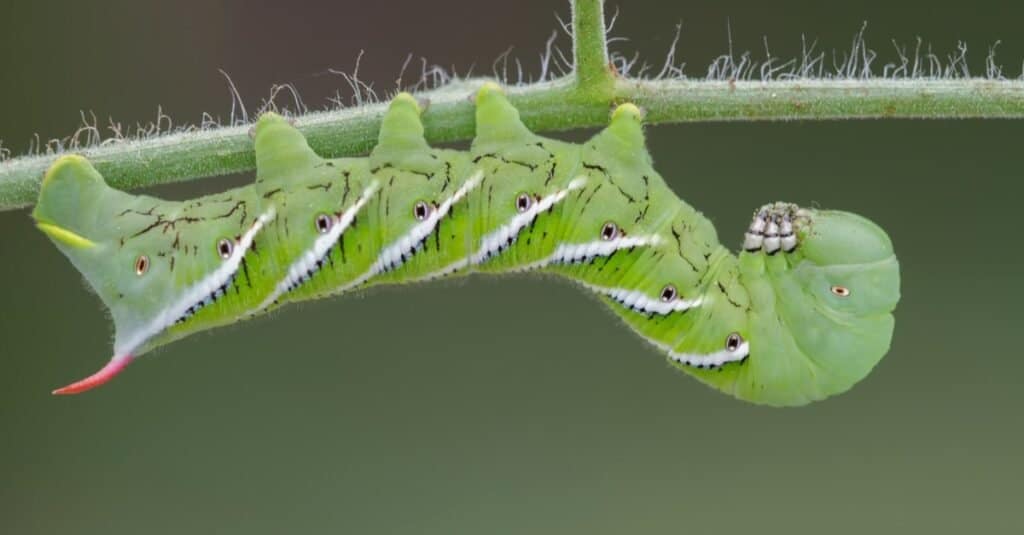When gardening, you’re likely to run into different critters and pests. Some insects are more concerning than others, and many require immediate action so they don’t ruin an entire plant (or garden). In fact, most gardeners’ worst nightmare is encountering an uncontrollable infestation of plant-killing pests. Knowing what to do in that situation is crucial to saving your garden and its vegetables and other plants.
One common (and harmful) insect you might find in your garden is the hornworm. Hornworms are a type of caterpillar that is deadly to plants, specifically those in the nightshade family. If you have hornworms on your plants or throughout your garden, keep reading to learn more about this pest and how to handle an infestation.
Introducing Hornworms: The Fascinating Green Caterpillars with Horns
Hornworms are of the Sphingidae family (a family of moths), also called hawk moths once they’re metamorphosed. There are two different hornworm species: tomato hornworms and tobacco hornworms. Hornworms get their name from their “horn”-like tails, which they use to scare off predators. Thankfully, hornworms do not bite or sting; for the most part, the only danger they pose is to the health of your plants. If left untreated, they can wreak havoc on your garden.
The tomato hornworm (Manduca quinquemaculata) is in the larval stages of the five-spotted hawk moth. Tomato hornworms are known to make homes in — you guessed it! — tomato plants, chomping on their leaves and destroying their chance of survival. However, this insect also feeds off solanaceous plants like tomatoes, eggplants, peppers, and (less commonly) potatoes.
The tobacco hornworm (Manduca sexta) is in the larval stage of the Carolina sphinx moth. As its name suggests, it often feeds off tobacco plants as well as solanaceous plants like the tomato hornworm.

Hornworms prefer plants in the nightshade family, such as peppers, tomatoes, and eggplants.
©J Gillispie/Shutterstock.com
Physical Characteristics: Exploring the Appearance and Features of Hornworms
Hornworms are some of the largest caterpillars, measuring up to 4 inches long. They have “horns” as tails that exist to scare away predators.
Since they’re the same shade of green as leaves on a plant, both types of hornworms can camouflage themselves to blend in with their plant prey. For the most part, they’re similar in size and appearance. However, they do have some distinctive characteristics that set them aside from each other. In particular, tomato hornworms have black or dark blue “horns,” while tobacco hornworms have red “horns.”
Additionally, tomato hornworms have five orange spots on their abdomen and eight yellow V-shaped lines down their bodies; tobacco hornworms, on the other hand, have six orange spots and seven white “lucky stripes.”
Life Cycle and Behavior: Understanding the Life Stages and Behavior of Hornworms
From egg to adult moth, the hornworm life cycle typically lasts about 30 days. The stages of maturity include egg, larvae, pupa, and adult moth. Here’s what each phase looks like.
Egg
An adult moth will typically lay eggs on the underside of a leaf, starting the hornworm life cycle. The eggs are translucent green and about 1 to 2 mm in diameter, hatching in about three to five days. If you identify eggs on your plants, you can pick them off, weed them, or even spray the leaves with nontoxic, natural pesticides to kill them before they can cause damage.
Larva or Caterpillar
Once they hatch and become larvae, these caterpillars will begin feasting on plant leaves. In fact, just a few larvae can consume an entire plant, all its leaves, and even its fruit. This stage lasts about two to four weeks and includes five instars, during which they shed their skin to prepare for more growth. This is when the hornworms do most of their damage to gardens. As they grow, they can consume larger amounts of plants.

Hornworms are technically in the larval stage of their life cycle before becoming moths.
©vbalson/Shutterstock.com
Pupa
Once they’ve got their food fixed and reach the pupa phase, hornworms will drop off plants and dig in the grown to prepare its “pupation chamber.” Depending on the season, some only take two weeks and emerge mid-summer, while others will stay burrowed through the winter until spring.
Adult Moth
Once hornworms undergo metamorphosis, they break out of the ground as adult moths with a wingspan of 4 to 5 inches wide. The five-spotted hawk moths and Carolina sphinx moths typically have a lifespan of about one to two weeks, rarely making it past six weeks. Before dying, however, they will typically lay their own eggs and restart the cycle.
Impact on Plants: Examining the Feeding Habits and Potential Damage Caused by Hornworms
During their caterpillar stage, hornworms can seriously damage plants and gardens. They feed on leaves, blossoms, and even fruit. A hornworm can completely defoliate a plant and become a significant problem in gardens — especially those that become infested with multiple larvae.
Typically, these caterpillars begin feasting on leaves on the upper parts of plants; once they’re done, they usually move to the blossoms and fruit. Often, they’ll travel from plant to plant, ruining multiple in the garden. Just a few hornworms can destroy an entire plant — especially when they reach full size.
Control and Management: Effective Strategies for Controlling Hornworm Infestations
If you think your garden has a hornworm problem, here are some useful tips for managing an infestation.
Identify the Culprit
Before taking action, understand exactly what you’re dealing with. To identify the pest, refer back to the physical characteristics of both hornworm types. Remember, these caterpillars can easily blend in with the leaves of your plants, so you might have to look extra hard to actually see them. A tell-tale sign of a hornworm is, of course, its horn-like tail.
Once you confirm you’re dealing with a hornworm, you can take the appropriate steps to eliminate them from your garden.
Pick the Hornworms off Your Plants
While it might gross you out, you can hand-pick these pests off your plants before they cause damage. After doing so, drop them into a bucket of soapy water to ensure they don’t return to your plants.
Allow Wasps to Lay Eggs
While wasps aren’t the ideal backyard insect to interact with, they can take care of your hornworm infestation. Once the wasp eggs hatch, they will feed on the hornworm’s insides and kill the insect before it can destroy your plants.

When wasp eggs hatch, the baby wasps can kill hornworms by feasting on their insides.
©Stephen Bonk/Shutterstock.com
Use a Natural Pesticide
Natural pesticides can help kill off hornworms in the case of infestation. If you need to gain immediate control over your hornworm situation, this is likely your best bet. Otherwise, it might be too late to manage the problem.
Apply Insecticidal Soap to Plants
Insecticidal soap will deter and/or kill small hornworms, preventing them from eating your plants and ruining your garden. Apply the soap to the undersides of the leaves and into the plant canopy.
Try Companion Planting
Planting “companion” plants can deter hornworms from attacking your nightshade plants. For example, planting basil near tomatoes can compliment its flavor while also repelling hornworms due to its strong scent.
Some additional companion plants include borage, flowers, parsley, yarrow, dill, mustard, and marigolds.
Till the Soil
Tilling your soil will kill most of the hornworm pupae (up to 90%!) that are undergoing metamorphosis or overwintering in your garden. This is because it exposes them to cold weather, which they cannot survive.
Rotate the Crops
Similar to tilling your soil, rotating your crops helps eliminate the number of pupae in your garden. This involves planting different crops in the same area of your garden/soil throughout different seasons. Crop rotation helps improve soil health while also combating pests.
If you’ve encountered the green hornworm, don’t fret: following the above tips will ensure your garden is pest-free in no time.
The photo featured at the top of this post is © mikeledray/Shutterstock.com
Thank you for reading! Have some feedback for us? Contact the AZ Animals editorial team.







